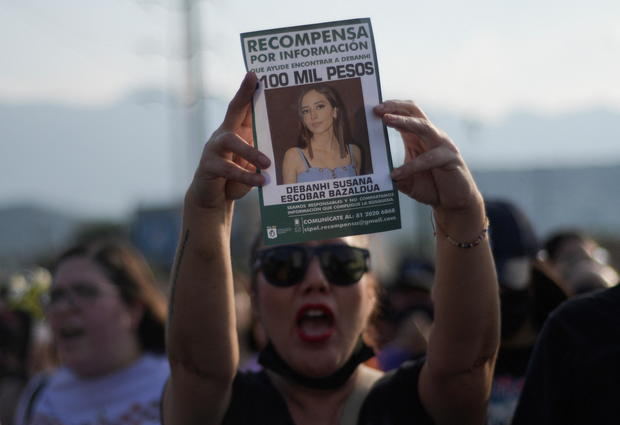
Hundreds of women marched through downtown Mexico City and its suburbs on Sunday to protest the horrifying death of an 18-year-old law student in the northern city of Monterrey.
Protesters also marched in the rough suburb of Nezahualcoyotl, where two women were killed in the last week. The demonstrators, mainly women, carried signs reading “No to Harassment” and “Mexico is a mass grave.”
QUETZALLI NICTE-HA / REUTERS
In Mexico City, the march was largely peaceful, unlike many previous women’s rights demonstrations in recent years. The demonstrators did not spray-paint slogans on the Angel, a tall stone monumental shaft commemorating the country’s independence.
Instead, they taped small missing posters on it, each one describing the disappearance of a woman. Many of the posters depicted Debanhi Escobar, whose body was found Thursday in a cistern at a motel in Monterrey, almost two weeks after she had gone missing.
Marchers chanted “Justice, justice!” and carried a banner reading “24,000 are missing” about disappeared women. Overall in Mexico, the number of missing people of all genders has risen to over 100,000.
Activists say police and prosecutors have been slow and ineffective in investigating the cases.
Those criticisms were reinforced when the father of Debanhi Escobar said authorities had searched the motel several times. But it wasn’t until workers reported a foul odor coming from an underground water tank that investigators finally found her body. She had died from a blow to the head, apparently soon after she was last seen April 8.
Her case shocked Mexico, because the young woman was left on the side of a highway late at night, purportedly after a taxi driver tried to fondle her.
The case made headlines because of a haunting photo taken by the driver, who was supposed to get her home that night.
The driver, who worked for a taxi app, took the photo to show the 18-year-old got out of his car alive on the outskirts of Monterrey. There she was, a young woman standing alone at night on the side of a highway, wearing a skirt and high-top sneakers.
The image seemed to speak of the tremendous vulnerability, and the self-assuredness – or desperation – of the young woman.
Nobody saw her again until late Thursday, when investigators managed to pull her body from the 12-foot deep water tank near a pool at the roadside motel.
STRINGER / REUTERS
On Tuesday, Nuevo Leon Governor Samuel Garcia said he would increase funding and resources to help combat gender violence, Reuters reported.
“We are working very hard to address the causes of this problem and I will be very clear: to the rapists, and those who commit feminicide, and all those who hurt the women of Nuevo Leon, know that we will find them and punish them to the fullest extent of the law,” Garcia said in a Facebook post.
Critics are disturbed by the fact that even when authorities are spurred to act by public outcry, investigations are seldom very timely or efficient.
Investigators said 200 personnel used drones, search dogs and reviews of security camera footage to look for Escobar, though her body was lying not far from where she exited the taxi.
Killings of women have increased in recent years in Mexico, rising from 977 in 2020 to 1,015 in 2021. Those were just cases classified as “feminicides” a legal term used in Mexico when women are killed because of their gender. Killings of women overall are much higher.
Disappearances of women remain high, with about 1,600 reported missing so far this year. Officials say 829 of them are still listed as missing, and 16 were found dead.

